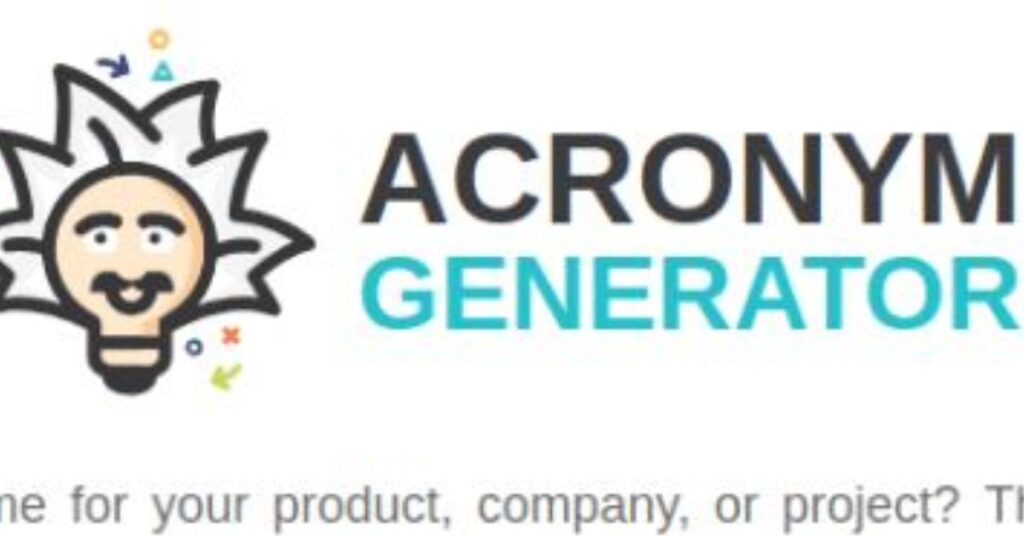Are you looking for a quick and easy way to create catchy acronyms? Whether for a business, project, or personal use, an acronym generator can help you brainstorm creative abbreviations that are both memorable and effective. But what exactly is an acronym generator, and how can it enhance your projects and branding efforts?
This article will dive into the world of acronym generators, how they work, their benefits, and the different ways they can be used. Let’s get started by understanding why acronyms are so useful and why an acronym generator might be the tool you didn’t know you needed.
What Is an Acronym Generator?
An acronym generator is an online tool or software designed to take words or phrases and create acronyms from them automatically. It can be as simple as converting a few words into initials or as complex as generating multiple variations of an acronym for you to choose from.
In many cases, an acronym generator can offer creative options that might not be obvious. This can be incredibly helpful when you need to create an acronym that stands out, whether for a business, event, product, or even a social media hashtag.
Why Are Acronyms Important?
Acronyms have become a cornerstone of communication in various fields. From businesses and technology to social media and everyday speech, acronyms help condense lengthy titles into short, memorable codes. Here are a few reasons why acronyms are effective and widely used:
- Memorability: Acronyms make names and titles easy to remember. For example, UNESCO is much simpler to recall than “United Nations Educational, Scientific and Cultural Organization.”
- Professionalism: Using an acronym can make a name sound more professional or sophisticated, adding credibility.
- Brevity: Acronyms save time and space, especially in digital communication where character limits can be an issue.
- Brand Identity: A well-chosen acronym can reinforce a brand’s identity and make it easier for customers to recall.
- Easy Recognition: In a world where attention spans are short, an acronym can help your brand or project stand out and become quickly recognizable.
How Does an Acronym Generator Work?
An acronym generator operates by taking a set of words you input and creating possible acronyms based on the initials or keywords. Here’s a step-by-step guide on how you might use an acronym generator:
- Input Your Words: Start by entering the words or phrase you want to create an acronym for.
- Generate Options: The generator processes the words and provides possible acronyms.
- Refine and Customize: Many generators allow you to add, change, or remove letters to customize your acronym further.
- Select the Best Option: Once you have a list of options, choose the acronym that best represents your idea or brand.
Some generators provide additional features, such as creating different variations or suggesting words to fill in missing letters if the acronym doesn’t spell a complete word.
Benefits of Using an Acronym Generator
An acronym generator can offer significant benefits, especially when you need an acronym quickly or if you’re looking for something unique. Here’s a breakdown of the top benefits:
- Time Efficiency: Rather than brainstorming on your own, you can generate a list of options in seconds, saving time for other tasks.
- Creativity Boost: An acronym generator often provides creative ideas you might not have considered. This can be a great way to find a memorable acronym with minimal effort.
- Brand Consistency: For businesses, having a short and catchy acronym can reinforce branding efforts and make communication more consistent.
- Versatility: Acronym generators can create options for various industries, purposes, and target audiences. They’re helpful for product naming, event titles, project codes, and more.
Applications of Acronym Generators Across Different Fields
Acronym generators can be useful across a wide range of applications. Here’s a look at some of the most common uses:
1. Business and Corporate Branding
Companies often use acronyms to brand divisions, products, and services. For instance, IBM (International Business Machines) is a well-known acronym. Using an acronym generator, businesses can quickly create unique and catchy abbreviations for internal and external branding.
2. Education and Research
Educational institutions, research projects, and academic papers often rely on acronyms for ease of reference. Acronym generators can create fitting acronyms for specific research projects or educational programs, simplifying communication.
3. Technology and IT Projects
In the tech world, acronyms are everywhere. Developers, project managers, and engineers can use acronym generators to name applications, frameworks, and tools. For example, API (Application Programming Interface) is a familiar acronym that has become an industry staple.
4. Marketing and Social Media Campaigns
Acronyms make hashtags easier to remember and share. For marketing and social media campaigns, an acronym generator can help create catchy and short hashtags that resonate with audiences.
5. Nonprofit and Government Organizations
Nonprofit and government sectors often use acronyms for their programs, services, and initiatives. Using an acronym generator helps create simple yet effective titles, making public communication easier.
Common Challenges in Choosing an Acronym
While acronym generators make creating acronyms easier, it’s still essential to keep a few considerations in mind. Choosing an acronym isn’t always straightforward, and some challenges include:
- Unintended Meanings: Acronyms can have alternate meanings, which may not always be appropriate. Be sure to double-check the potential implications of any acronym.
- Availability: If you’re planning to use an acronym for branding, you’ll need to ensure that the acronym isn’t already widely recognized for another organization or product.
- Pronunciation and Readability: Ideally, an acronym should be easy to pronounce and remember. If it’s too complex or awkward to say, it might not have the intended impact.
An acronym generator can help mitigate these issues by offering a variety of options, allowing you to choose an acronym that best suits your needs.
Tips for Selecting the Perfect Acronym
- Keep It Short and Simple: Aim for an acronym that’s concise. Ideally, stick to three or four letters unless the phrase itself requires more.
- Make It Unique: If possible, try to pick an acronym that isn’t commonly used in your industry to ensure it stands out.
- Consider Readability: Ensure your acronym is easy to pronounce. This makes it more memorable and easier to share.
- Test It with Your Audience: Sometimes, the best way to know if an acronym works is to test it with a sample audience to gauge reactions.
Popular Acronym Generators to Try
If you’re interested in using an acronym generator, here are a few popular tools to consider:
- Acronym Creator: Known for its easy-to-use interface, this tool generates a wide range of acronyms for various fields.
- Wordlab Acronym Generator: This generator allows users to input words and produces creative options that work well for branding.
- Namelix: Namelix combines AI to generate business names and acronyms, making it suitable for those looking for brand-oriented options.
- Acronymify!: An acronym generator known for its range of suggestions, from simple initials to more complex ideas.
Each of these generators can help you brainstorm, experiment, and select an acronym that aligns with your goals.
Conclusion:
Acronyms have become integral in how we communicate, whether in professional, educational, or casual settings. An acronym generator offers a fast, efficient, and creative way to produce catchy abbreviations that can simplify communication and improve brand recall.
Whether you’re naming a new business, project, or social media campaign, an acronym generator can streamline your creative process. With various tools available online, it’s easier than ever to create unique acronyms that make an impact.







